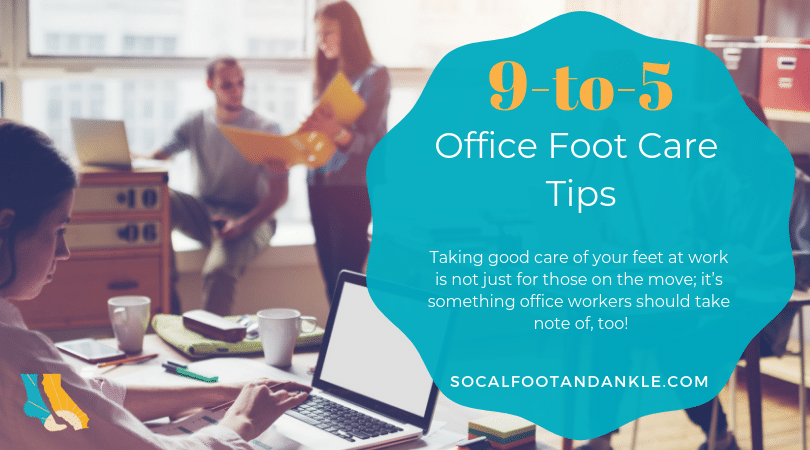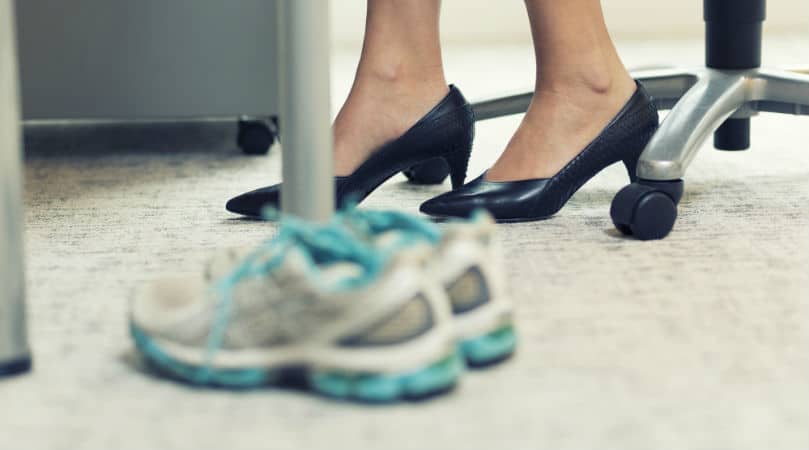9-to-5 Office Foot Care Tips
Some jobs definitely come with more risks than others. These are the kinds of jobs that require steel toe boots, harnesses, and perhaps some healthy knowledge of workers’ compensation—just in case.
But just because a job might be behind a desk instead of atop a construction site does not mean it completely lacks potential negative effects. This is especially true if your job often leaves you sitting throughout the day.
We’ll take a closer look at how a sedentary office lifestyle can be detrimental to your feet and lower legs over time. Fortunately, there are several easy steps you can take to help maintain better foot health while at the office—and they just feel great in general, too!
What Office Life Can Do to Your Feet
We spend a lot of our lives sitting—and for some of us, about a third of our day can be spent affixed to a chair. Although this has become a common part of life, we were not really built to spend so much time in one position.
The consequences of such a lifestyle can have effects throughout the body. However, the feet and ankles specifically can suffer ill effects from so much time sitting in many different ways.
One significant concern deals with circulation to the legs and feet. Maintaining proper circulation to the feet is already a decent challenge for our bodies. The feet are the farthest parts of our bodies from our hearts, so there is already quite a distance to cover compared to elsewhere in the body. And then you realize the trip back is often a long trek against gravity!
When we sit for prolonged periods of time, circulation can slow even further. This can lead to blood pooling in the legs and feet.
While swollen ankles and feet are a frequent consequence of this affect, it also brings risks of varicose veins and even dangerous blood clots.
Another common condition that sitting for long periods does not help is heel pain. For someone who suffers from plantar fasciitis, a long stretch of time spent not stretching the plantar fascia can lead to significant temporary pain when they do rise from their chairs.
You can also experience general foot and lower leg pain from long periods of inactivity or having your sitting posture in an odd position. That sort of muscular ache you feel is basically a cry for attention—either to use those muscles, or to correct a situation that is causing stress in the lower extremities.
Over the long run, with years of time spent sitting, deeper effects can come to light. The effectiveness of insulin within our bodies can decrease, increasing our risk of diabetes (which can be particularly bad on our feet!). Chances of weight gain and muscle weakness also rise, interfering with our endurance and stability.
The fate of an office worker seems bad, but there’s hope!
What You Can Do to Fight Stagnation
Just because you might be stuck at a desk all day doesn’t mean you’re helpless against the consequences. It does not take a huge amount of effort to improve your time at work in a significant way. A lot of it comes down to finding ways to move away from your desk, and even at your desk.
Move a Bit Every Hour
Half the day can fly by before you even realize you’ve been in your chair that whole time. Spending just a couple minutes every hour getting up and moving around can make a big difference to your feet and circulation.
Go to a co-worker’s desk instead of firing off an e-mail. Grab a cup of coffee. Heck, you can even go to the bathroom. As long as you are standing and moving about, it helps!
What if you use a standing desk? That’s good, but just standing is not enough, either. Make sure you move those feet.
Accrue About 30 Minutes of Activity Each Day
What is meant by “activity” here? We’re looking for a middle-of-the-road sort of movement at least, such as taking a brisk walk.
This doesn’t have to be done during work hours, nor does it all have to be done at one time, either. You could choose to have three 10-minute bouts of activity and have one or two of them be 10-minute break walks during work. After hours, chores such as yard work or cleaning can also count. Studies support the notion that breaking your activity into chunks is just about as effective as doing it all at once.
Of course, if you want to get into workouts, running, and higher forms of activity, that’s even better! Just make sure to do so responsibly by starting anything new slowly and gradually building up your intensity over weeks. It’s no good if you give yourself an overuse injury right out of the gate.
Work Your Feet at Your Desk
Even when you’re sitting and typing away, that doesn’t mean your feet must be still. Stretch your feet beneath your desk—ideally with your shoes off, if allowed—with movements that include wiggling your toes and flexing your ankles.
If heel pain is something you struggle with—and even if it’s not—having something to roll beneath your foot from the heel to the base of your toes can help keep the plantar fascia active and give you a good massage to boot.
A simple tennis ball can serve as an effective roller, but you can enhance your rolling time by filling a plastic bottle about four-fifths of the way with water and freezing it. It provides a great rolling surface as well as some ice therapy! However, you might want to exercise some caution if you have a lot of electronic items beneath your desk. You don’t want to accidentally leak water onto anything.
Be Professionally Proactive
Making movement a part of your office day can be a significant boon to your body in the long run. A work culture should encourage such actions, so they can even be worth championing to bosses.
Another approach that can greatly help your foot and ankle health is finding areas of concern before they have the chance to cause you lasting harm. From abnormal foot structures that can benefit from custom orthotics to developing bunions that can be countered, we can help you determine the best course of action for your foot care now and well into your career.
Call our Ladera Ranch office at (949) 364-9255 (WALK) to schedule an appointment. If you prefer to reach us electronically instead, please feel free to do so via our online contact form.


